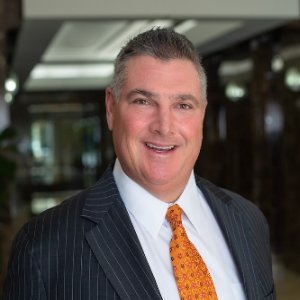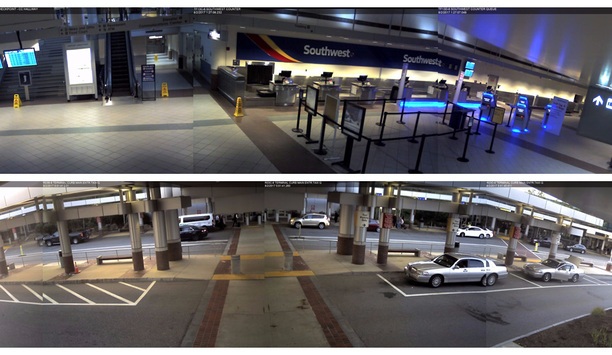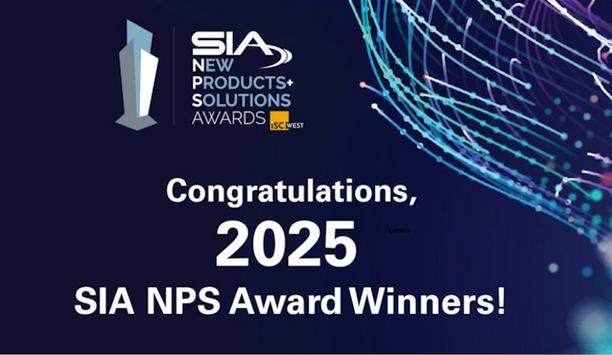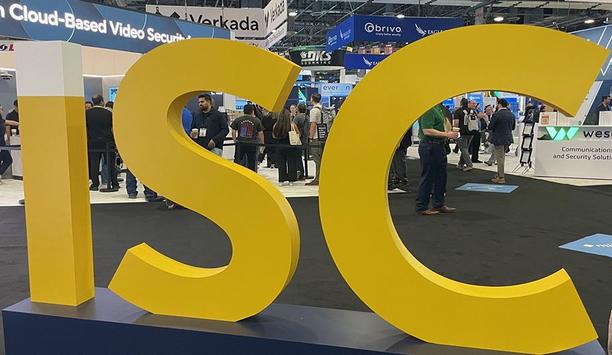Allied Universal - Experts & Thought Leaders
Latest Allied Universal news & announcements
Manchester-Boston Regional Airport opened to serve the state of New Hampshire and the surrounding New England community in 1927, a little over two decades after the Wright brother’s first powered flight. Located three miles south of central Manchester, the Manchester-Boston Regional Airport is the fourth largest passenger and third largest cargo airport in New England. The airport is also the busiest in the state, qualifying under the Federal Aviation Administration (FAA) as a “small hub primary commercial service facility.” Airport redevelopment project The 1990’s brought a large redevelopment project to the airport, sparking more modern facilities, increased room for aircraft, and a range of new shops and restaurants. By 2012 it had become clear that the airport and its parking areas required enhanced surveillance. Increased foot traffic, manpower, and federal safety regulations resulted in the awarding of an FAA grant for a new surveillance system.Increased foot traffic, manpower, and federal safety regulations resulted in the awarding of an FAA grant for a new surveillance system The Manchester-Boston Regional Airport faced a lengthy decision-making process when it came to security camera manufacturers, requiring products able to support the unique applications and varied environment of the airport. The security team monitored a range of spaces both in and outdoors, and required products that excelled under all of these varying situations and lighting conditions. The selected cameras needed to provide full high-definition video across multiple open areas, while also delivering detailed, close-up images within busy, crowded spaces. The airport’s FAA grant included stipulations regarding the types of products that could be purchased with the supplied funds, specifying that the selected system must qualify under the “Buy American” standard. This provision meant that all potential selections not only meet the technical requirements, but also be Made in USA. AV Costar: foundation for security system After a year of exploring the market, the client determined that AV Costar was the only manufacturer that not only satisfied the “Buy American” stipulation, but did so without sacrificing the airport’s fundamental security requirements by providing a wide range of high resolution megapixel cameras.AV Costar was open in demonstrating its Made in USA product design, manufacturing, quality control, and support as part of the selection process AV Costar was open in demonstrating its Made in USA product design, manufacturing, quality control, and support as part of the selection process. Securadyne Systems was selected as the systems integrator. Extensive planning determined which AV Costar products to install, where to do so, and how the installation process would be accomplished. Once Manchester-Boston Regional Airport chose AV Costar cameras as the foundation for their security system, they began to collaborate with On-Net Surveillance Systems, Inc. (OnSSI) to supply the video management system (VMS). OnSSI is an AV Costar Technology Partner Program member, with many joint customers around the world, demonstrating proven integration between the two company’s products and support services. Arecont cameras chosen by airport security team The AV Costar SurroundVideo® multi-sensor camera series piqued the security team’s interest for its 180° panoramic capabilities. Passengers, staff, and aircraft crew move frequently and often swiftly from one location to another in varied lighting, yet all proved trackable with the SurroundVideo cameras and the OnSSI software. The placement of SurroundVideo cameras at the Manchester-Boston Regional Airport provides comprehensive coverage while reducing the number of cameras needed overall, a feat that was especially useful in large areas such as the airport’s apron. The security team chose cameras from the AV Costar MegaDome® series, which are equipped with a wide range of innovative features For locations that required a single coverage view, the security team chose cameras from the AV Costar MegaDome® series, which are equipped with a wide range of innovative features. Features such as low light capabilities and remote focus and zoom all proved crucial to the airport’s requirements. Casino Mode™ is available in the 1080p versions of the MegaDome series, a feature that proved to be as useful at the Manchester-Boston TSA checkpoints as it is in a Las Vegas casino. Casino Mode guarantees 30 frames per second to capture every detail on fast-action applications, an incredibly effective tool when investigating security situations involving many complex, small movements for both live and forensic viewing.Casino Mode guarantees 30 frames per second to capture every detail on fast-action applications for many complex, small movements in both live and forensic viewing Investigating criminal or worker concerns Manchester-Boston Regional Airport has installed over one hundred and fifty AV Costar cameras, and the video surveillance system is continuing to grow. The latest installation of AV Costar products included the lower level of a parking garage as well as a newly renovated passenger checkpoint area. When asked if there are any specific incidents in which AV Costar cameras proved useful, Mr. Mueller responded, “Every other day we use the cameras to investigate criminal or worker concerns. We go back and monitor them for possible safety issues on the ramps, for passenger interaction, and for worker interactions. Anytime someone expresses a concern to me, they can come in and we can watch the footage together. I try to make sure that the option to view footage is fairly transparent, which has proved very useful to everyone. "SurroundVideo 180° cameras were again utilised in the latter situation due to the client’s satisfaction with stitching together images from multiple 180°s." Paul Mueller, Manchester-Boston Regional Airport’s security manager, stated, “We were sure to go back to AV Costar during this process. We have had a good working relationship with them for the past five years, and they enable us to use less cameras while still maintaining full view of inspection areas.”Primary camera views are displayed and monitored all the time, while others can be pulled up and played back as issues arise Passport and ticket inspection made easy AV Costar cameras are monitored 24/7 in the airport’s communications centre. Primary views are displayed and monitored all the time, while others can be pulled up and played back as issues arise. The system also allows for particular divisions within the Manchester-Boston Regional Airport to monitor cameras that are applicable to their work, such as in the parking garage. In terms of responsiveness, AV Costar makes it a top priority. “We had an issue recently with the lack of detail in some of the views for when people were having their passports and tickets inspected by TSA employees,” Paul stated, “An AV Costar rep came out and agreed that we could improve images, so he pulled the cameras and re-installed a newer firmware version which allowed for finer adjustments, completely and efficiently solving our problem.” AV Costar prides itself in its relationship with clients such as Manchester-Boston Regional Airport and to its continued design and manufacturing of quality, innovative, and industry-leading cameras within the United States for customers to use worldwide.
Allied Universal®, the world’s pioneering security and facility services company, announced its Unified Command Centre solution was recognised as an honourable mention in the 2025 Security Industry Association (SIA) New Products + Solutions (NPS) Awards - less than 30% of nominations received this recognition. The solution was honoured in the Managed Services category at the awards ceremony held at the ISC West conference this week in Las Vegas. Advancing security solutions “It’s an honour to be recognised by the 2025 SIA New Products + Solutions Award program for our pioneering-edge mobile unified command centre,” said Steve Jones, global chairman and CEO of Allied Universal. “This recognition reflects our team’s dedication to advancing security solutions that deliver exceptional results, and we remain committed to continuous innovation to help enhance safety worldwide.” Real-time video analytics Allied Universal’s Unified Command Centre is a security hub integrating real-time video analytics Allied Universal’s Unified Command Centre is a rapidly deployable security hub integrating real-time video analytics, seamless communication, and intelligent incident management. Supported by a dedicated team, it optimises logistics, enhances decision-making, and enables swift threat detection and response. Designed for dynamic environments, it delivers comprehensive situational awareness and adaptable security. SIA NPS Awards “The SIA NPS Awards are a renowned global platform for highlighting new offerings each year, and earning recognition is an impressive accomplishment,” said Elisa Mula, vice chair of the SIA NPS Awards Committee and founder and protection management specialist at EM Designs. “SIA applauds this year’s winners, who impressed our judges after an extensive process of tech demonstrations and panel-driven judging.” Innovative physical security products According to the SIA website, “the SIA New Products + Solutions Awards reflect the evolution of the security industry and the convergence between physical and cyber security products…a panel of judges with extensive industry experience reviewed new products and solutions from top exhibiting brands in 33 different categories, including the prestigious Best New Product and Judges’ Choice Awards.” Established in 1979, the SIA New Product + Solutions Awards recognise innovative physical security products, services, and solutions that are used to help protect of life and property in residential, commercial and institutional settings.
The Security Industry Association (SIA) has announced the 2025 winners of the SIA New Products and Solutions (NPS) Awards, the flagship awards program presented in partnership with ISC West, recognising innovative security products, services, and solutions. Top among the winners, who were recognised April 2 during an award ceremony at the Bridge Stage on the ISC West show floor, was Vaidio, receiving the 2025 Best New Product Award. SIA NPS product and service categories SIA NPS has been the security industry’s premier product awards program Since its inception in 1979, SIA NPS has been the security industry’s premier product awards program. New products are reviewed by a panel of judges with extensive industry experience, and in 2025, following significant deliberations, the 38 judges presented awards for technologies covering 33 product and service categories. The 2025 SIA NPS Awards entries will be on display through Friday, April 4, in Booth #25075 on the ISC West show floor, adjacent to the Bridge Stage (Booth #25059). Vaidio 9.0 advanced models Vaidio received the Best New Product honor for its Vaidio 9.0 AI Vision Platform product, submitted in the Loss Prevention and Article Surveillance Solutions category. “Vaidio 9.0 enhances loss prevention by combining advanced (artificial intelligence) models, heuristic rules and intelligent compute management to deliver precise analytics for detecting theft and reducing inventory shrinkage,” said Vaidio. “Its unique orchestration of CNN, transformer and VLM models increases accuracy, reduces compute consumption and improves speed, while integrating seamlessly with existing infrastructure.” AI-driven engagement The prestigious Judges’ Choice Award was presented to RAD for the SARA The prestigious Judges’ Choice Award was presented to Robotic Assistance Devices (RAD) for the SARA – AI Security Agent for Autonomous Threat Detection and Response product, submitted in the Threat Detection and Response Solutions category. “SARA revolutionises (global security operations centers) and monitoring by transforming passive surveillance into real-time, AI-driven engagement,” said RAD. “This autonomous security agent detects threats, interacts with individuals, verifies intent and escalates incidents as needed, enhancing security efficiency, reducing operator fatigue, preventing overlooked events and ensuring faster, smarter and more effective incident response across diverse environments.” Amazing new products and solutions “This year’s SIA NPS program has had another fantastic year with amazing new products and solutions presented to our judging panels,” said Christine Bergeron, chair of the SIA NPS Awards Committee and senior director of global physical security technology at Visa. “Thank you to our expert judges and committee members for your dedication to the program and lending your expertise and valuable time to contribute to a successful 2025 SIA NPS program.” Advancement of SIA and the security CyberLock received the NPS Merit Award, which admits an person or company who, through their support of SIA “The SIA NPS Awards are a renowned global platform for highlighting new offerings each year, and earning recognition is an impressive accomplishment,” said Elisa Mula, vice chair of the SIA NPS Awards Committee and founder and protection management specialist at EM Designs. “SIA applauds this year’s winners, who impressed our judges after an extensive process of tech demonstrations and panel-driven judging.” Additionally, CyberLock received the NPS Merit Award, which recognises an individual or company who, through their support of the SIA NPS Awards, demonstrates a commitment to the vision and mission of the program, contributes to its success and promotes the advancement of SIA and the security industry overall. New security technology solutions “SIA congratulates all the winners of the 2025 SIA NPS Awards, and especially Vaidio and Robotic Assistance Devices, whose products stood out among the entries to earn the Best New Product and Judges’ Choice distinctions, as well as SIA NPS Merit Award winner CyberLock,” said SIA CEO Don Erickson. “Each year, NPS presents the most cutting-edge products available on the market today, and our judges’ dedication, support and thorough consideration are invaluable in maintaining it as the most trusted awards program for launching new security technology solutions.” 2025 SIA NPS award winners Best new product award Winner: Vaidio – Vaidio 9.0 AI Vision Platform Judges’ choice award Winner: Robotic Assistance Devices – SARA – AI Security Agent for Autonomous Threat Detection and Response SIA NPS Merit award Winner: CyberLock Category awards Access Control Devices & Peripherals Hardware – Wireless Winner: Sure-Fi – Sure-Fi Access Pro Bridge Access Control Software, Hardware, Devices & Peripherals – Wired Winner: Safetrust – IoT Neural Sensor Honorable Mention: Accessia – Accessia Reader Antiterrorism/Force Protection/Armed Aggressor Winner: Xonar Technology – TruePort Biometrics Winner: Intel RealSense + Ones Technology – BioAffix Gate Vision Powered by Ones Technology and Intel RealSense ID F450 Communications and Networking Solutions Winner: Commend Americas – Ivy Live Translation – Ivy Virtual Assistant’s Multilingual Real-Time Translation Capabilities, Part of Commend’s Symphony Cloud Solution for Security Communication Convergence and Integration Solutions Winner: AURA – AURA Auto Guard Dispatch Data and Systems Cybersecurity Winner: SWEAR – SWEAR Security Design, Diagnostic and Installation Tools Winner: dormakaba – EntriWorX Insights Enhanced Project Delivery Winner: Vaidio – Vaidio 9.0 Environmental Monitoring Systems Winner: XSponse – X-Shield Honorable Mention: Secure Passage – Truman Fire/Life Safety Winner: Honeywell – Connected Life Safety Services (CLSS) Compliance Manager With Auto-Pass Honorable Mention: Honeywell – CLSS Cloud-Connected Horizon Identification Management and Credentialing (Nonbiometric) Winner: Wavelynx, rf IDEAS and Idemia (Founding Companies of LEAF Community) – LEAF Community Intrusion Detection and Prevention Solutions (Physical) – Wired or Wireless Winner: SPOT AI – SPOT AI Remote Security Agent Honorable Mention: Hexagon – HxGN dC3 LidarVision Key/Equipment Assets Management Solutions Winner: CyberLock – ValidiKey Pro Law Enforcement/Public Safety/Guarding Systems Winner: 3Si Security Systems – DirectToDispatch Honorable Mention: Eagle Eye Networks – Eagle Eye 911 Camera Sharing Lock and Key Solutions Winner: dormakaba – CenconX OTC Safe Lock Honorable Mention: Securitech ASSA ABLOY – PARAMAXX Loss Prevention and Article Surveillance Solutions Winner: Vaidio – Vaidio 9.0 AI Vision Platform Managed Services Winner: ADRM – DEFENDER Honorable Mention: Allied Universal – Unified Command Center Mobile Solutions Winner: Intel RealSense + Ones Technology – BioAffix Vision Mobile Powered by Intel RealSense ID 450 Threat/Risk Management Software Applications Winner: Bearing – Bearing Honorable Mention: Sign In Solutions – Sign In Solutions – Risk Insights Threat Detection and Response Solutions Winner: Robotic Assistance Devices – SARA – AI Security Agent for Autonomous Threat Detection and Response Honorable Mention: Xtract One Technologies – Xtract One Gateway Video Analytics Winner: Lumana – Lumana Video Intelligence Platform Video Surveillance Advanced Imaging Technologies Winner: Axis Communications – ARTPEC-9 Video Surveillance Cameras Winner: Hanwha Vision America – 4CH AI Multi-Sensor Camera With WAVE VMS Powered by the NVIDIA Jetson Platform Honorable Mention: Axis Communications – AXIS Q1809-LE Bullet Camera Video Surveillance Hardware and Accessories Winner: Spectrum Camera Solutions – F200 Series Explosion-Proof Housing System Video Surveillance Management Systems Winner: Monitor Computer Systems – Sentinel
Insights & Opinions from thought leaders at Allied Universal
ISC West 2025 in Las Vegas showcased the latest advancements in security technology, offering security professionals a glimpse into the future of the industry. This year's expo highlighted the growing influence of artificial intelligence (AI), cloud computing, and enhanced integration. The pioneering comprehensive and converged security event attracted nearly 29,000 industry professionals to the Venetian Convention Centre. Integration into unified platforms Several companies emphasised the importance of cloud-based solutions and the integration of diverse security components into unified platforms. For example, Brivo's Security Suite provides “everything in one platform” – not just access control. Customers only pay for what they use because the system is flexible and scalable from a single door to enterprise level applications. Brivo’s suite includes video, but the system can also tie in with third-party “partners.” Genetec's Security Centre allows for more frequent updates through the cloud. Milestone is undergoing a two-year transition to bring its Xprotect system into the future by incorporating Arcules and Briefcam into a video-as-a service product. Suprema introduced BioStar X, which integrates access control and video analytics into a single platform. AI and mobile credentials Axis Communications’ Cloud Connect product announced three new partnerships at ISC West 2025 Axis Communications’ Cloud Connect product announced three new partnerships at ISC West – Eagle Eye Networks, SecuriThings, and Wesco. They join the three partners announced during the first year of Axis Cloud Connect – Genetec, Kone (elevators) and Milestone. AI and mobile credentials were still hot topics at ISC West 2025, but the conversation has evolved beyond amazement at the technologies’ capabilities and now centres on more practical aspects. From the theoretical to the practical “AI and mobility are still the ‘flavors de jour,’ but messages are evolving to manifest AI for better outcomes,” says Heather Torrey, General Manager, Commercial Security, Americas, for Honeywell Building Automation. The company has reframed its security portfolio to be very building- and business-focused, continuing to grow and evolve after the recent acquisition of LenelS2. “From the theoretical to the practical, we want customers to be part of the conversation so we can deliver AI that is meaningful to them, focusing on what’s most important,” says Torrey. Under Honeywell’s new ownership structure, “each part of the business can be more focused on customers’ needs,” she says. Honeywell continues its journey around mobile access and credentialing and migrating to cloud solutions. Innovations in Access Control Gallagher’s new Quickswitch access control board simplifies the migration from legacy systems Access control remains a critical component of security systems, and ISC West 2025 showcased several innovations in this area. Acre is releasing “Gallery,” its version of the App Store for access control. DormaKaba is launching the Keyscan KC Series door controller with TCP/IP connectivity and enhanced features. Gallagher’s new Quickswitch access control board simplifies the migration from legacy systems. Johnson Controls highlighted its C-Cure command centre and C-Cure IQ web client, offering a unified approach to access control and video. Hardware integrations for security panels For service provider Alarm.com, hardware products prepare a path to greater customer experiences, says Abe Kinney, Alarm.com’s Director, Product Management, who oversees hardware integrations for security panels, sensors, video, etc., and drives new product development. “We are looking to bridge the physical world to digital world,” he says. “We want to bring an advantage to our dealers that they can bring to customers.” Because Alarm.com’s customers pay a monthly fee, the products must be durable and economical, says Kinney. “It should work with no need for truck rolls.” The importance of longevity and flexibility Products are evaluated based on features, price, and ease of installation Products are evaluated based on features, price, and ease of installation. In particular, longevity is important for the Alarm.com’s pro channel. There is also a growing emphasis on deterrence industrywide. Says Kinney: “We recognise that detection is part of it, but we need to prevent problems from happening in the first place. And the industry is re-evaluating.” When it comes to cloud intelligence, Eagle Eye Networks puts the emphasis on flexibility. They offer AI that can perform anywhere on the system infrastructure, on the camera, on their on-site bridge device, or in the cloud. They support their own AI and also any AI product from a third party. “We focus on what customers want from the data AI detects,” says Hans Kahler, Eagle Eye Networks’ Chief Operating Officer. Integration with other systems A timely alert from gun detection could save a life, but AI can also generate information that might be used and analysed later, such as point-of-sale information, dwell time, foot traffic, etc. “What people want is the ability to work with the data for business intelligence,” says Kahler. Integration with other systems provides new opportunities for customers: For example, a licence plate reader at a restaurant drive-thru could trigger customisation of the menu board digital signage based on the customer’s previous buying pattern. Relentless Innovation Assa Abloy handles more than 40 million SKUs for all its various brands, faked in 28 factories in the US Assa Abloy handles more than 40 million stock keeping units (SKUs) for all its various brands manufactured in 28 factories in the United States. Merely complying with regulations such as the “Buy American Act” is a monumental effort considering the massive product line, attendees heard at Assa Abloy’s Annual ISC West Breakfast focusing on compliance challenges in the security market. Meanwhile, back at the trade show booth, Assa Abloy focused on “relentless innovation” in every corner of its product line. Assa Abloy’s message: Innovation in security does not have to be about AI or automation. In fact, inventive approaches to products come in all shapes and sizes and at every level of the product portfolio, and innovation is happening faster than ever. For example, the Safebolt product from Securitech, a brand recently acquired by Assa Abloy, can quickly lock down existing doors with the press of a red button on a cylindrical or mortise lock. Temporary Systems to Secure Events Securing events is the focus of Allied Universal's Unified Command Solutions, which specialises in setting up temporary security systems for conventions, trade shows, festivals, construction sites, parades, and other events. They can add technology to situations where previously mostly security officers were used, providing safety/security and enabling more efficient event operation. “We can put cameras anywhere, whether they need power or not, use cell service or WiFi, a localised network or the internet, or whatever,” says Andrew LaMadrid, VP, Sales for Allied Universal's Unified Command Solutions. Event operation and management IDIS came to ISC West looking to leverage new products that they did not promote in the past The focus is on easy implementation, flexibility, and fast setup and removal. “We look for a solution to solve each customer’s pain points,” says LaMadrid. They specialise in setting up and deploying surveillance cameras for safety/security and for event operation and management. Mobile surveillance is a relatively new “piece of our puzzle” when it comes to protecting high-profile events. “People are excited about what we can offer that’s new,” says LaMadrid. Unified Command Solutions has been around for about 12 years and was acquired by Allied Universal last summer. IDIS came to ISC West looking to leverage new products that they did not promote in the past, and visitors were very interested in those solutions, says Scott Switzer, IDIS CEO. “The progression of our product line has been tremendous,” he says. Last year, the IDIS booth offered only basic analytics, but this year they had 30 different advanced analytics including gun and aggression detection using the advanced solution “IDIS Vaidio AI.” What Makes You Different? The most common question IDIS hears at their trade show booth is: “What makes you different?” The answer: They offer an end-to-end solution, including cameras; they manage, control, design from end-to-end; and there is no need for multiple integrations. The time needed to install an IDIS system is significantly less because of the simplicity. “We have customers we have supported and grown together for over 20 years,” says Switzer. The company previously deployed IDIS cameras under the Costar brand before the Korean IDIS brand was introduced into the U.S. (IDIS purchased Costar and changed the name to IDIS America.) “This has been a tremendous show for us; we are looking to build our momentum and let more people know about IDIS,” says Switzer. Managing real AI at the edge The depth of their metadata enables new applications, whether for security or business operations Based in Prague, Czech Republic, and with U.S. offices in Pennsylvania, FF Group provides licence plate recognition for harsh environments. Using Axis cameras, they offer “managed real AI at the edge,” selling through a nationwide distributed network, says Alex Osypov, CEO and Founder of FF Group. Markets include parking lots, cities/municipalities, police, government, water systems, etc. The depth of their metadata enables new applications, whether for security or business operations. They are looking to combine and correlate data including LIDAR, RADAR, etc. to exploit the advantages of “data fusion.” Osypov says: “The market is growing because we are involving other adjacent markets.” Unified platforms and advanced tools Several companies are focusing on enhancing security operations centres (SOCs) by providing unified platforms and advanced tools. Axon’s Fusus system “layers” onto existing infrastructure, tying together various sensors into a single interface for real-time monitoring and information sharing. Increasingly, enterprises have invested in a lot of technologies – ac, video, asset trackers – but none of it talks together. Fusus ties all the systems together so that operators no longer have to look at 10 different screens. Rather, there is a “single pane of glass” that shows everything and facilitates sharing of information with law enforcement. Motorola also showcased its Security Operations Centre, which integrates hardware, software, smart sensors, communication radios, and broadband devices to streamline incident management.
The practice of executive protection changed forever on Dec. 4, 2024, when UnitedHealthcare CEO Brian Thompson was shot outside a Manhattan, New York, hotel. The shocking event raised awareness in board rooms around the world about the need for, and challenges of, executive protection. Questions followed immediately, including why was the high-level executive not protected? Combination of risk and reward UnitedHealthcare’s stock price has gone down more than 20% since the shooting The event also highlighted what is at stake for companies, extending beyond the safety of executives and impacting many factors, even including a company’s stock price. UnitedHealthcare’s stock price has gone down more than 20% since the shooting, equating to tens of billions of dollars. “Companies are considering the combination of risk and reward like never before when it comes to executive protection,” says Glen Kucera, President of Allied Universal Enhanced Protection Services. “What are the chances this could happen? Before Dec. 4 many thought it was zero. And what are the financial implications for a company if it happens? Executive protection is a small investment to protect against a worst-case scenario.” Evaluation of an executive protection Before the UnitedHealthcare shooting raised awareness, fewer than 50% of executives had protection. But concerns that previously fell on deaf ears now have the full attention of companies, says Kucera. “Boards of directors are having to figure this out,” he adds. “They may not have executive protection, but now they have to do it.” A threat assessment, conducted by a company such as Allied Universal, provides an independent evaluation of a company’s executive protection needs. The assessment evaluates factors such as an executive’s travel habits, the safety of their home, etc. Does the executive need protection 24/7, or just when they travel into more dangerous areas? Risks increase related to corporate earnings Sometimes, cases increase the need for executive protection, such as an internal threat In assessing threats, security professionals also look beyond the individual to consider the safety of a corporate facility, for example. “Is there a visual deterrent, controlling who comes and goes?” asks Kucera. “If there is good security, it all ties together. We do home assessment, facility assessment, route assessment, and travel assessment as needed.” Sometimes, circumstances increase the need for executive protection, such as an internal threat. Timing is a factor, and risks increase related to corporate earnings releases, new product announcements, and corporate layoffs or consolidation. Monitoring social media tracks shifting threats that impact the need for executive protection. UnitedHealthcare shooting “He didn’t have it and probably didn’t think he needed it,” comments Kucera about the UnitedHealthcare executive who was gunned down in the streets of New York City. “He was staying at the hotel across the street and was used to walking down the street every day.” “Sometimes executives want to preserve their privacy and be able to walk down the street,” says Kucera. “Getting protection can be seen as a sign of weakness. Some CEOs in the past have said they just didn’t want it.” However, the UnitedHealthcare shooting raised the stakes of the need for more vigilance. “The bottom line is you have to yet beyond objections and make the investment to protect against a worst-case scenario,” says Kucera. Anti-capitalist sentiment in the general population An internal police bulletin warned of an online hit list naming eight executives and their salaries Threats to executives sometimes arise from anti-capitalist sentiment in the general population about perceived inequalities in wealth and power. Executives provide symbolic targets for anyone who fights the system, and social media has amplified the voices of those who oppose capitalism. For example, a "Most Wanted CEO” card deck seeks to shine a spotlight on "titans of greed." Also, in the aftermath of the UnitedHealthcare shooting, CEO "wanted" posters appeared across New York City, threatening various executives of large companies. An internal police bulletin warned of an online hit list naming eight executives and their salaries. Careful monitoring of social media posts Careful monitoring of social media posts and other sources enables executive protection professionals to analyse data and separate the dangerous threats from the merely negative ones. Sadly, positive support of the UnitedHealthcare shooting was expressed by the 300,000 or so followers of the shooter, who became a celebrity of sorts. A huge outcry of negative sentiment toward the insurance industry led to fear that copycat incidents might occur. “There has been an unprecedented amount of positive support for committing murder,” commented Kucera. Executive protection requests HR executives can be at risk, especially at a time of layoffs or consolidation “Let’s face it, there has been a lot of controversy, from COVID to the Middle East crisis, to the political campaign, and there is negativity on both sides,” says Kucera. “People have opportunities to pick sides, and there is a lot of sentiment going both ways, and there is a small percentage of people who will act aggressively.” Executive protection requests now extend beyond the CEO to include others in the management ranks of companies. Basically, any public-facing executive is at risk, including anyone who makes statements to the press. Human resource (HR) executives can be at risk, especially at a time of layoffs or consolidation. Private information on the Internet Typically, an executive is assigned a single armed operative for protection. The firearm serves primarily as a visual deterrent that hopefully makes a potential perpetrator think twice. “When they plan an event like this, their expectation is that it will be a soft target,” says Kucera. “If there is an officer, it gives them pause.” Controversial or high-profile CEOs are typically protected 24/7, including when they travel with their family. Adding risks is the fact that private information is now posted on the Internet, including where an executive lives and where their children go to school. Internet monitoring Internet monitoring also includes the “dark web,” which includes sometimes dangerous information “We offer social media monitoring, and we advise them to be more careful with what they post,” says Kucera. “We monitor reactions to posts including any that might be threatening. We watch social media carefully if a company announces earnings or a change in their service or product offering.” Internet monitoring also includes the “dark web,” which includes sometimes dangerous information that is intentionally hidden and requires specific software, configurations, or authorisation to access. Own layer of protection Public and government officials can also come under fire in a variety of scenarios. FEMA officials faced threats after the recent floods in the Southeast, for example, among other situations where perceived unfair treatment promotes thoughts of retribution. Although government agencies have their own layer of protection, there are instances when they call on companies such as Allied Universal for additional help. Ad hoc protection for various executives In the aftermath of the UnitedHealthcare shooting, calls to Allied Universal’s Command Centre increased by 600%, reflecting requests for ad hoc protection for various executives. These requests are in addition to the company’s business providing “embedded” operatives that travel with executives all or some of the time. On that side of the business, requests for services are up probably 300%, says Kucera. {##Poll1742194323 - Has the recent increase in violent threats changed your company's view on executive protection?##}
It’s clear that despite recent layoffs in the tech industry and general unease about the economy, there are still significant gaps in the number of jobs available and the amount of workers available to fill them. According to the Labour Department, there are 5.5 million more job openings than workers available. The physical security industry is not immune to these shortages. Last fall, Allied Universal reported being unable to fill thousands of open roles nationally while other smaller security-related companies also cited difficulties finding workers to fill open roles. Reported instances of burnout among security professionals are contributing to this. Physical security programs In one report, 84% of security pros and 80% of other workers felt burned out. The same report claims that burnout can lead to missteps and employees experiencing burnout were three times as likely to think that security rules and policies ‘aren't worth the hassle,’ compared to respondents who were not experiencing burnout. In one report, 84% of security pros and 80% of other workers felt burned out As security leaders look to address some of these concerns for long-term gain, there’s a new discussion to be had: Can technology bridge the gap between worker shortages and the need for robust physical security programs? Implementing technology that streamlines decision-making is one way to try and address retention within a physical security department, but technology in general may contribute to solving this issue. The role of virtualised GSOCs Mature businesses rely on a Global Security Operations Center, or GSOC, to collect and analyse information about threats to the organisation, its people, and its assets. But the resources required to properly staff and maintain a GSOC are beyond the reach of many businesses, including startups. This presents a challenge: the world is simultaneously more connected and dispersed than it’s ever been which makes managing physical security risks more critical – and more difficult – than ever before. Add in the challenge of sourcing talent for these operator and analyst positions, and many businesses might not be able to stand up a GSOC that can adequately serve the organisation. Centralised physical location A vGSOC performs the same functions without the need for a centralised physical location Many established enterprises rely on a physical GSOC to serve as the command and control centre for their security programs. These secure locations are where threats are identified and analysed and the appropriate response is determined. A vGSOC performs the same functions without the need for a centralised physical location, which saves money, enables scalability, is inherently more redundant, and gets the security program up and running more quickly than bringing a physical GSOC online. vGSOCs can also help organisations address worker shortages and staffing challenges by outsourcing the physical security function and providing additional support that may not have been available previously. Promoting remote work options We’re entering a period of remote work-centric operations, with a recent report by Ladders stating that nearly 25% of all professional jobs in North America will be remote by the end of 2022. This means that remote work is here to stay – and it may be contributing to the worker shortage when remote work is not an option within an organisation. As such, technology contributes to enabling more remote work functionality As such, technology contributes to enabling more remote work functionality. Organisations who want to retain workers by promoting remote and hybrid work options have to plan long-term investments in IT infrastructure that support these workers, account for security threats – both physical and cyber – and foster a supportive environment that embraces remote workers. Addressing false alarms In physical security, security leaders are tasked with making decisions in a split second using information that they have at their fingertips – and receiving hundreds of alarms each day can quickly lead to burnout and an increased risk of missing a true security event. The ‘noise’ generated by disparate systems within a GSOC, funnelled through security guards and analysts to assess and respond to can become debilitating. In some regards, the various systems within the GSOC – from access control, video feeds, analytics alerts, intrusion and fire alarms, Dark Web monitoring, and much more – can create so much of this noise that the actual event might be missed. Building scalable program It’s critical that physical security leaders start identifying and implementing technology Operators cannot digest all of these false alarms and noise long-term without experiencing the kind of burnout mentioned earlier. For many organisations to handle the amount of alarms coming in at any given point, leaders have to either add more bodies or implement technology to address these challenges. And as we’ve mentioned, shortages are plaguing even the largest companies. The good news is that we’re in a period of time where there are many available technologies that implement artificial intelligence (AI) to help address this noise and reduce the number of false alarms there are. It’s critical that physical security leaders start identifying and implementing technology to help retain their operator talent and build a scalable program for protecting people and assets. The case for advanced technology In a recent webinar, Travis May from Groove Jones said that having technology that’s innovative helps keep security operators working in GSOCs engaged. With the technical advancements in not only supporting remote and hybrid workers but also opening up the option for security operators to work virtually, physical security is taking a step forward in modernising its approach to building the modern workforce.
Using artificial intelligence (AI) to automate physical security systems
DownloadA modern guide to data loss prevention
Download7 proven solutions for law enforcement key control and asset management
DownloadThe truth behind 9 mobile access myths
DownloadAccess control system planning phase 2
Download





















































